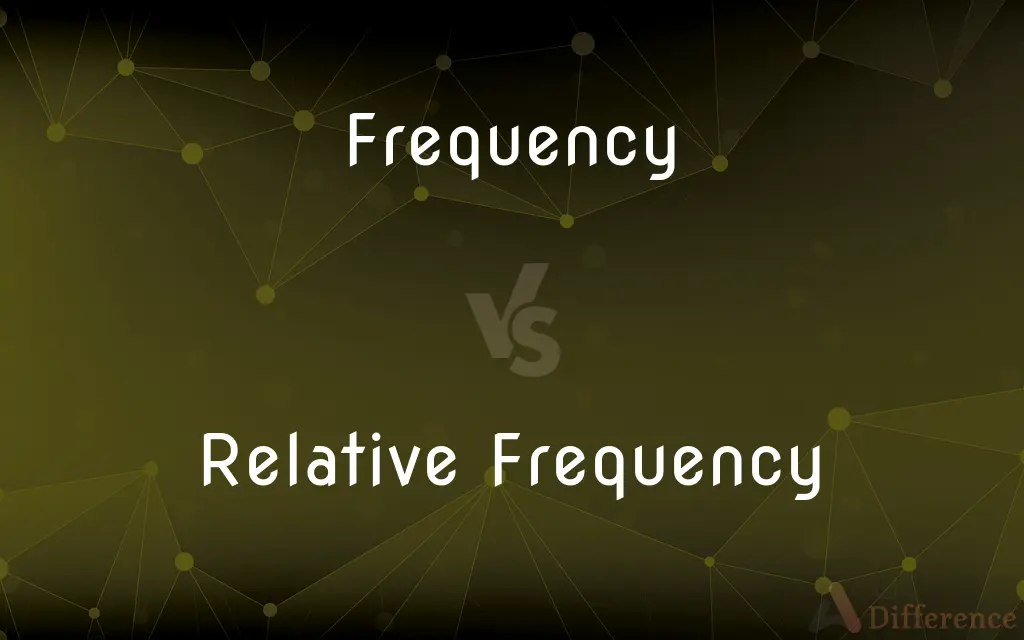Frequency vs. Relative Frequency — What's the Difference?
By Urooj Arif & Fiza Rafique — Published on March 1, 2024
Frequency refers to how often something occurs within a dataset, while relative frequency is the proportion of times a value occurs relative to the total number of observations, expressing frequency as a fraction or percentage.

Difference Between Frequency and Relative Frequency
Table of Contents
ADVERTISEMENT
Key Differences
Frequency and relative frequency are key concepts in statistics used to describe data distributions. Frequency counts the number of times a particular data point appears in a dataset. It provides a simple way to understand the raw number of occurrences of each value. For example, in a survey of favorite fruits, the frequency would count how many times "apple" is chosen.
Relative frequency, on the other hand, divides the frequency of each data point by the total number of data points, often expressed as a percentage. This gives a clearer picture of how significant or common a specific value is within the context of the entire dataset. Using the same fruit survey, relative frequency would show what proportion of all fruit choices were "apple."
Frequency can quickly tell you which items are most common or least common, while relative frequency provides insights into the structure of the data, highlighting the importance of each category in relation to the whole. This is particularly useful in large datasets where understanding the proportion of categories can offer more insight than absolute numbers.
Calculating relative frequency can help in comparing datasets of different sizes. Because it's a proportion, it enables a fair comparison between different groups or samples, making it a valuable tool in statistical analysis for identifying trends or patterns across varying conditions or populations.
Frequency offers a straightforward count of occurrences, whereas relative frequency contextualizes these occurrences, providing a more comprehensive understanding of the data. Both are essential for data analysis, serving different purposes in the exploration and interpretation of statistical information.
ADVERTISEMENT
Comparison Chart
Definition
The count of how often each value appears.
The proportion of each value to the total count.
Expression
Absolute number.
Fraction or percentage.
Purpose
Identifies the number of occurrences.
Shows the significance of occurrences relative to the total.
Calculation
Count each occurrence.
Frequency of an occurrence / Total occurrences.
Usefulness
Highlights most/least common items.
Facilitates comparison across different datasets.
Compare with Definitions
Frequency
The total count of specific occurrences.
The frequency of rainy days last month was 8.
Relative Frequency
The fraction or percentage of times an event occurs.
The relative frequency of choosing an apple was 20%.
Frequency
Can be tallied for any type of data.
The frequency of high scores in the game surprised everyone.
Relative Frequency
Allows comparison across different datasets.
Using relative frequency, they compared survey responses.
Frequency
Simple to calculate and understand.
They calculated the frequency of customer complaints.
Relative Frequency
Helps in identifying patterns or trends.
Relative frequency analysis revealed an increasing interest in online courses.
Frequency
Measures how often something happens.
His frequency of visiting the café was twice a week.
Relative Frequency
Compares frequency to the total number of observations.
Her relative frequency of wins was 0.5.
Frequency
Basis for constructing histograms.
The histogram's bars represented the frequency of grades received.
Relative Frequency
Useful for understanding data distribution.
Relative frequency showed most sales occurred in July.
Frequency
The property or condition of occurring at frequent intervals.
Frequency
The number of repetitions of a complete sequence of values of a periodic function per unit variation of an independent variable.
Frequency
The number of repetitions per unit time of a complete waveform, as of an electric current.
Frequency
The number of measurements or observations having a certain value or characteristic.
Frequency
(statistics) number of times an event occurred in an experiment (absolute frequency)
Frequency
The ratio of the number of observations in a statistical category to the total number of observations
Frequency
The number of observations in a given statistical category
Common Curiosities
Why is relative frequency important?
Relative frequency provides context to the raw frequency counts, allowing for comparisons across datasets of different sizes and understanding the distribution of data.
What is frequency?
Frequency is the count of the number of times a particular value or event occurs in a dataset.
Can frequency and relative frequency be the same?
In a dataset of one observation where that event occurs once, the frequency and relative frequency would be the same (1 and 100%, respectively), but this is a rare and trivial case.
How do you calculate relative frequency?
Calculate relative frequency by dividing the frequency of a particular event by the total number of observations.
How are frequency and relative frequency used in data analysis?
Frequency identifies common and rare events, while relative frequency helps understand the significance and distribution of these events within the dataset.
What is relative frequency?
Relative frequency is the proportion of times a specific value occurs in relation to the total number of observations.
Can relative frequency exceed 1?
No, since relative frequency is a proportion of the total, it ranges from 0 to 1 (or 0% to 100% when expressed as a percentage).
How does sample size affect relative frequency?
While the actual frequency depends on sample size, relative frequency normalizes this, allowing for comparisons regardless of sample size.
How does the concept of relative frequency apply to probability?
Relative frequency is closely related to empirical probability, where the likelihood of an event is estimated based on observed occurrences.
Is relative frequency applicable to continuous data?
Yes, but continuous data must first be categorized into bins or intervals, after which relative frequency can be calculated for each bin.
Why might two datasets with the same frequencies have different relative frequencies?
If the total number of observations differs, the same frequencies will result in different relative frequencies, reflecting their different proportions within each dataset.
What is the relationship between frequency and relative frequency?
Relative frequency is derived from frequency, representing it as a proportion of the total occurrences.
What is a frequency distribution table?
A frequency distribution table lists the frequencies of different data points in a dataset, often accompanied by relative frequencies for a comprehensive view.
Can relative frequency help in predicting future events?
Yes, by understanding the distribution of past events, relative frequency can offer insights into the likelihood of future occurrences.
What tools are used to calculate and visualize frequency and relative frequency?
Tools range from simple tallying and calculators for small datasets to software like Excel, SPSS, or R for larger datasets.
Share Your Discovery

Previous Comparison
Power of Attorney vs. Conservatorship
Next Comparison
Mealworms vs. SuperwormsAuthor Spotlight
Written by
Urooj ArifUrooj is a skilled content writer at Ask Difference, known for her exceptional ability to simplify complex topics into engaging and informative content. With a passion for research and a flair for clear, concise writing, she consistently delivers articles that resonate with our diverse audience.
Co-written by
Fiza RafiqueFiza Rafique is a skilled content writer at AskDifference.com, where she meticulously refines and enhances written pieces. Drawing from her vast editorial expertise, Fiza ensures clarity, accuracy, and precision in every article. Passionate about language, she continually seeks to elevate the quality of content for readers worldwide.
















































